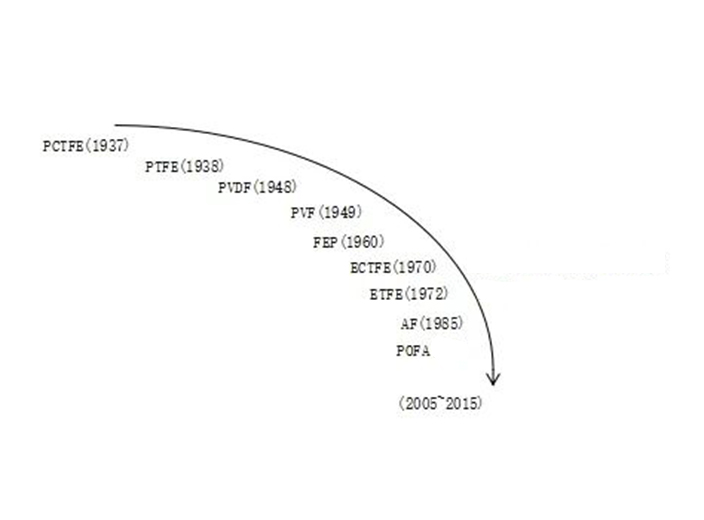Polytetrafluoroethylene (PTFE): The "Plastic King" of Fluoropolymers
Feb 28, 2022Fluorine-containing polymer refers to a type of polymer in which all or part of the hydrogen atoms connected to C-C bonds in the polymer are replaced by fluorine atoms. Fluoropolymers are complex in structure, various in variety and widely used, and are usually divided into three types: fluororesin, fluororubber and other fluoroproducts.
Fluoropolymers account for 20% of the total fluorine consumption in the fluorochemical industry. Since American scientist Plunkett synthesized polytetrafluoroethylene in 1938, the products that have been industrially produced and marketed so far include polytetrafluoroethylene (PTFE), polyvinylidene fluoride (PVDF), ethylene-tetrafluoroethylene copolymer ( ETFE), ethylene-chlorotrifluoroethylene copolymer (ECTFE), polyvinyl fluoride (PVF), more than 10 varieties and more than 100 brands.

The difference between suspension PTFE resin and dispersed PTFE resin: The PTFE obtained by suspension polymerization can be shaped and processed, while the dispersed PTFE cannot be shaped and processed, but it can be processed by the method of dispersion coating or converted into powder for paste extrusion. . The difference in the quality of suspended PTFE and dispersed PTFE is due to their particle size, particle size distribution and particle morphology. 350nm). Polytetrafluoroethylene is refractory and has poor fluidity, and its particle size and particle shape have an important impact on melt fluidity, its processing performance and product performance.
2. Industry structure
PTFE is polymerized from the monomer tetrafluoroethylene (TFE), and TFE is obtained by thermal cracking of difluoromonochloromethane (R22). At present, the mainstream TFE production process in the world adopts the steam dilution cracking method. Japan's Daikin and British ICI company jointly developed and put into industrial production. The process features high single-pass conversion, few by-products, and high TFE selectivity. The development of this technology in the domestic PTFE industry began in the late 1970s. Under the auspices of the Second Bureau of the Ministry of Chemical Industry, it was successfully put into production in the early 1990s after the Shanghai Synthetic Rubber Research Institute and other factories and colleges jointly tackled key problems. Thousand-ton TFE industrial equipment and promotion nationwide.
PTFE is formed by free radical polymerization of TFE. Its polymerization methods include bulk polymerization, solution polymerization, suspension polymerization, emulsion polymerization (dispersion polymerization), and suspension polymerization and dispersion polymerization are mainly used in industry. At present, suspension resins account for 50%-60% of the global production capacity, dispersion resins account for 20%-35%, and the rest are dispersion emulsions.
1) Suspension polymerization method: Suspension polymerization of tetrafluoroethylene is carried out in an aqueous medium with persulfate as an initiator, by smashing, grinding, washing and drying to prepare a suspension polymerization resin. Suspension polymerization is relatively mature and is the main method for synthesizing PTFE in industry.
2) Dispersion polymerization method: It is obtained by dispersing and polymerizing tetrafluoroethylene in an aqueous medium, using perfluorocarboxylate as dispersant and fluorocarbon as stabilizer under the initiation of persulfate or its redox system. Dispersion liquid. The dispersion liquid is coagulated, washed and dried to form a dispersed polymer resin, or heated and separated in the presence of ammonium carbonate and an emulsifier, and the clear liquid is poured out to make a concentrated dispersion liquid with a solid content of 60%.
The global PTFE industry has experienced several mergers and acquisitions during the years of development. For example, in 1999, the British ICI company sold its polymer business to Japan's Asahi Glass Company; Germany's Hearst Company sold 46% of its Dyneon company's shares. To joint venture partner 3M Company of the United States; Belgian Solvay Company acquired Italy's Ausimont Company, etc. At present, overseas PTFE has formed a relatively concentrated industry structure. The main manufacturers include DuPont (Chemours) in the United States, ICI in the United Kingdom, Daikin in Japan, Dyneon in Germany, Ausimont in Italy, Russia's Kirov Chemical Complex, etc.
Based on the excellent properties of fluoropolymers, it plays an important role in the transformation and upgrading of traditional industries such as the automotive industry, chemical industry, power industry, food industry, aerospace and construction. From the perspective of downstream applications: 1) The chemical industry is the largest consumption field of fluororesin, which mainly utilizes the excellent properties of fluororesin in corrosion resistance, high and low temperature resistance; 2) The second is the machinery industry, where fluororesin is processed into various parts; 3) The amount of fluororesin consumed in the electrical and electronic industry is also relatively large, mainly because of its excellent dielectric properties; 4) The amount of fluororesin consumed in the coating industry is also increasing, mainly because of its chemical and physical properties. Stability and self-cleaning. In addition, textiles, cooking utensils, medical equipment and other aspects also consume a certain amount of fluororesin.